11.11.2014 | 8:00 am
A Note from Fatty: If really all you want from today’s post is a link to the online store, just click here. However, if you don’t read the whole thing, you may not find out that you won a tricked-out Ibis of your choice and also helped save the world.
Being the incredible writer I am, every single sentence I type is a precious gift to the universe. Each word is a beautiful, perfectly-formed gemstone, each essay a verbal gem-tastic mosaic.
At will, I can make you laugh. I can make you cry. I can make you shake your head in awestruck wonder.
I can say, in all humility, that I deserve each and every one of the Bloggies I have won.
And I have won a lot. Like, four of them.
As you might expect, the greatest challenge I have had in compiling this, the second volume in The Best of FatCyclist.com (which I have whimsically named The Great Fatsby) is selecting what not to include. I have agonized. I have wrung my hands in anguish. I have considered making this into a 4200-page book.
But—showing remarkable strength and fortitude—I have done it. And here is the cover.
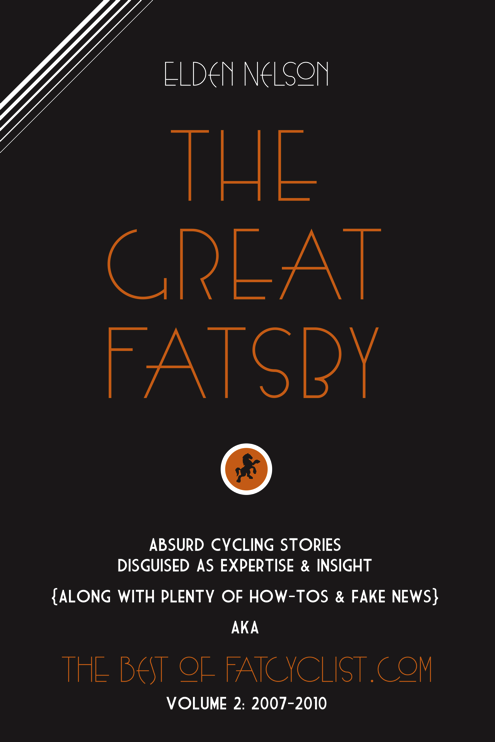
About The Great Fatsby
Puffery aside, The Great Fatsby honestly is some of the very best humor writing I’ve ever done. That may be because it was during this period that Susan was fighting cancer; writing was a defense of sorts. (The serious posts from this same period, along with the rest of the story, will be Volume 3, which I plan to publish in a year.)
I picked out the top 5% of my writing from this period, gave each story a little bit of introductory context, added some new jokes, and footnoted the heck out of the thing.
Like this:
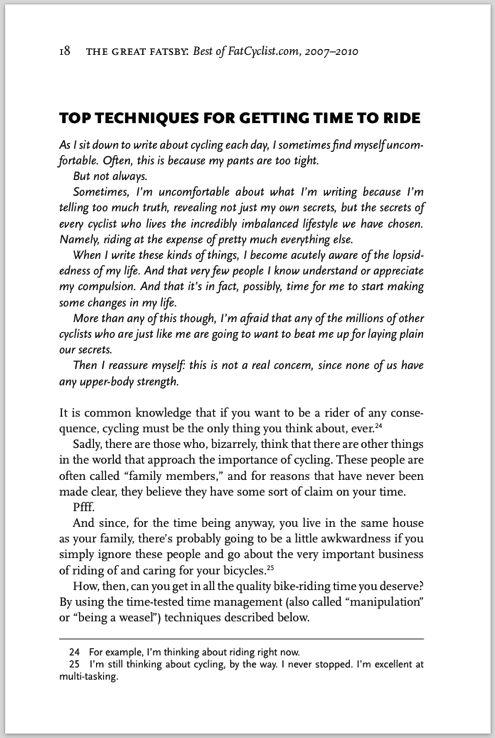
The stories are now grouped into topical sections (E.g., “Things You Already Know,” “Introspection and Fart Jokes,” “Strong Opinions On Trivial Matters”), and are, for the first time…edited. A little bit.
And perhaps best of all, Dan Wuori—the hilarious back-page columnist for Velo—wrote the foreword for the book. And the Backword. And the Middleword.
Yes, this book has a Middleword. I think every book should have one.
Win a Dream Bike, Help WBR Make the World a Better Place
The Great Fatsby is available as a pre-order right now, and will be shipped on or about December 10: plenty of time to get to you before Christmas. You can order just the book itself, a signed copy, or a copy with a personal inscription.
It will also be available as a Kindle book, starting in mid-December.
But If I were you, I’d consider maybe reading on a bit further before deciding what you’re going to buy. Because I’ve got some awesome stuff and awesome deals that go with The Great Fatsby.
And someone’s going to be winning the Ibis bike of their choice, completely tricked out with top-of-the-line SRAM components.
For example, maybe you’d like to get the full-suspension, go-everywhere, do-anything Ripley 29 (which, built up with SRAM XX1, RockShox suspension front and back, and Rise, Roam, or RAIL wheels, would retail for more than $9000):
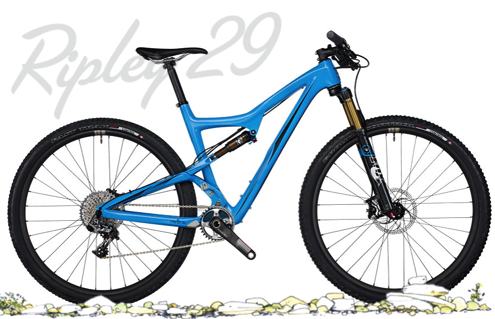
Or maybe you’re more of a hardtail type rider. Maybe you want to try out singlespeeding, or maybe you would like to travel with your bike. In that case, maybe you’d like to get the exact bike that I got for myself, and have been riding and loving this year: The Ibis Tranny 29, similarly built up to the nines with SRAM parts:

Or how about an Ibis Hakkalugi Disc go-anywhere CX machine, built to perfection with the SRAM Force CX1 groupset?
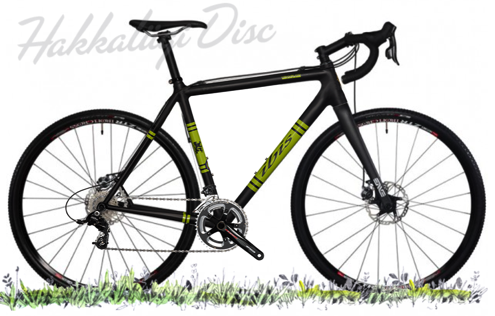
I gotta say, that is a seriously tempting CX machine. If I had that bike, I might actually start racing CX.
Or you could get yourself any of the flavors of one of the most beloved mountain bikes out there: The Ibis Mojo.
Why a Contest?

Why is there a contest component to this pre-order? Because I like to give cool stuff away, for one thing. But more importantly, because 25% of the profits of this pre-order—including the book sales and the pre-order of everything else I’m about to show you—will go to World Bicycle Relief.
I’ve seen firsthand how a bicycle donated to a student can completely change her life’s potential. I’ve ridden with a health care volunteer as she went from home to home, miles apart, meeting with people she takes care of.
In short, I’ve seen the power of the bicycle, and I’m proud to be donating a quarter of the profits from this book to World Bicycle Relief.
But here’s the cool thing: that donation will be anonymously matched. So it will actually be like half the profits from this book will go to World Bicycle Relief.
Not bad, huh?
The Team Fatty Tecno-Merino Wool Long Sleeve Jersey
I’ve been friends and riding buddies with DNA Cycling—a high-end cycling clothing manufacturer that is HQ’d here in Utah, but manufactures its clothing in Italy—for years.
I recently struck up a conversation with them about, in short order, creating a really beautiful, incredibly comfortable Merino wool jersey that would look and feel great before, during, and after cool weather rides.
This is what DNA Cycling designed for me. Let’s take a look at the front and back:
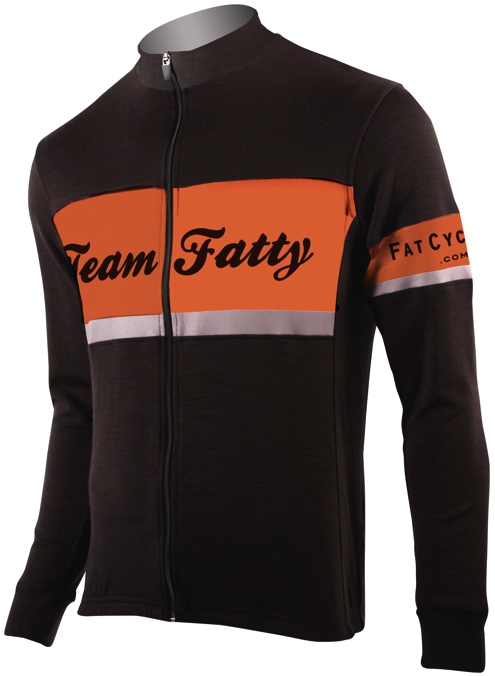
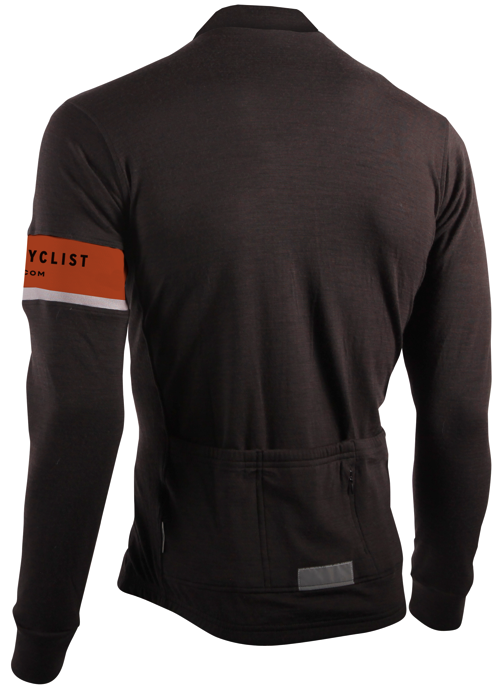
Here are the details of this beautiful, beautiful jersey.
- Tecno-Merino is a wool-poly blend that is incredibly soft and comfortable. You can wear it right against your skin without ever itching, at all.
- Full Zipper, and 3 Pockets: In other words, this is a fully-functioning, hard-working jersey. Not a sweater masquerading as a jersey. But it’s so gorgeous you can (and will) wear it wherever.
- Hidden Zipper Pocket: There’s an extra pocket in the back, to keep money, your credit card, and a key secure when you ride. You don’t need that stuff falling out on accident when you reach behind you to get out a gel.
- Between Race and Club Cut: I recommend you treat this as if it were a race cut and go up a size. Maybe two, if you put on pounds during the winter like I do. Yeah, that’s right. I’m thinking I’ll get an XL.
- There are Lots of Sizes Available. It’s bummed me out for a long time that I run a blog called FatCyclist, but don’t ever have jersey sizes past 3XL. Well, this jersey goes from 2XS to 5XL. Unisex sizing. [Note: Sizing info is at the bottom of the product description.]
Above all else, I am offering this jersey at a ridiculously killer price: $124.95. That’s $25 less, at a minimum, than you’ll pay for an equivalent jersey elsewhere.
And if you buy it as part of a bundle with an autographed, inscribed book, the cost is $139.90: you’ll save $15 over buying them separately. [Fact: This is the best Christmas present in the whole world.]
Or you can make me love you forever by getting the Super Bundle, containing the signed and inscribed book, the long-sleeved jersey, and the t-shirt shown below, and save $20.
And yes, this jersey enters you into the contest to win the Ibis of your choice. And 25% of the profits go to World Bicycle Relief.
The Great Fatsby T-Shirt
People will see you wearing this t-shirt, and they will wonder how it’s possible that you managed to make such a grievous spelling error .
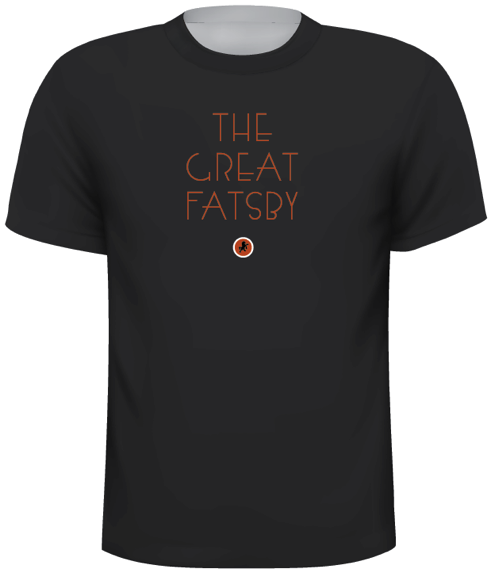
That is, of course, their own problem. Whether you choose to set them straight is up to you (but I think you should).
And here’s the back of the t-shirt:

This is a 100% ringspun, 4.3oz cotton, with a really nice hand feel. It’s not going to shrink unless you do terrible things to it, and it’s sized from Small to 3XL in both women’s and men’s cuts.
You can get this t-shirt by itself, or get it with a signed book and save $5.00. Or get the Super Bundle (a signed and inscribed book, a long-sleeved jersey, and this t-shirt), with a savings of $20.
[Note: Sizing info is at the bottom of the product description.]
How the Contest Works
With every book, jersey, t-shirt, or bundle you buy, I’m donating $25% of the profits to World Bicycle Relief. Also, for each item you buy, you’re getting a certain number of chances in the random drawing I will make on December 10, 2014. The number of chances is specified in the item description, but roughly corresponds to the cost of the item.
The winner of the drawing will get to choose any Ibis frame, in the color and size of her/his choice. You may have to wait if the frame/size/color of your choice is not in stock.
No purchase is necessary. To enter the contest without making a purchase, write a cogent, well-reasoned on-topic essay of between 400 and 500 words describing why you think The Great Fatsby is either a good or bad choice for a book title. The essay quality will not be a factor in whether you win, but will be used as a guard against bot-generated entries. Use the subject line “The Great Fatsby Contest Entry,” and send the email to fatty@fatcyclist.com.
Submitted essays become the property of FatCyclist.com, and may well be published, with or without commentary, whether you win or not.
This contest, and pre-order period, ends at midnight, December 3, 2014.
Thank You
So, to recap and in general put the hard-sell on you, when you buy a book, jersey, t-shirt, or bundle during the pre-order, you get that cool thing, you get a chance at winning a cool bike, World Bicycle Relief magically gets a quarter of the profit turned into half the profit.
I’ve been writing this blog for nearly ten years now. I still love it, and I put a lot of work into it. I hope you’ve enjoyed it too, and find it worth your money to pick up a copy of The Great Fatsby (and associated gear).
Thank you!
PS: If you have any questions, please ask in the comments section; I’ll do my best to answer right away.
Comments (37)
11.10.2014 | 12:51 pm
I’m super-duper excited to announce that I am hard at work on my new book: The Great Fatsby.
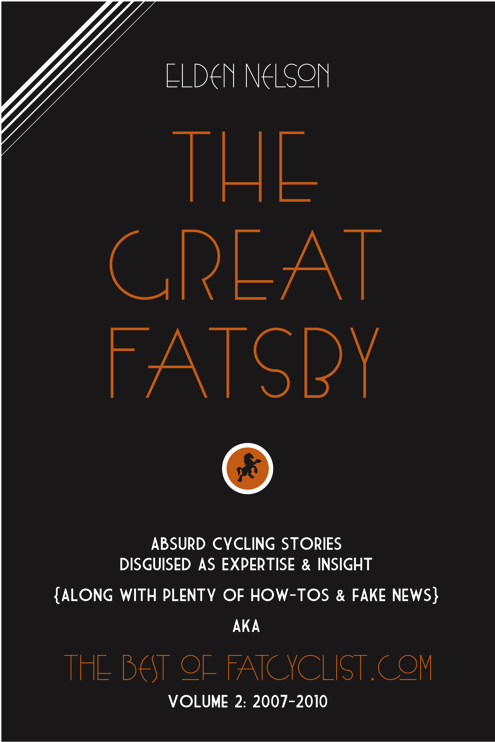
I’ll be opening it up for pre-order tomorrow, and will have it in your hands by Christmastime.
This is, frankly, some of the funniest stuff I ever wrote. You know, from back when I was hungry and funny and hadn’t yet sold out. Or whatever.
You know me well enough by now to know that I can’t help myself: this book will benefit a good cause, and there will be an incredible grand prize I will be giving away to some lucky person.
I’m also excited to say that along with this book, there’ll be a t-shirt you can buy:
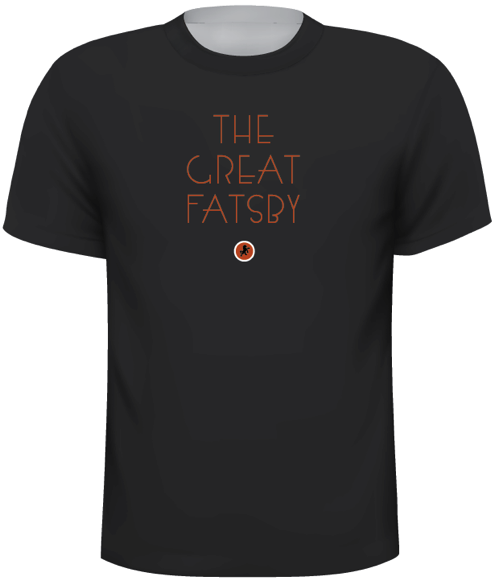
Almost most of all, though, I’m almost insane with delight at this long-sleeved tech-merino wool jersey I’ll be making available, at an absurdly great price when you buy it with The Great Fatsby. 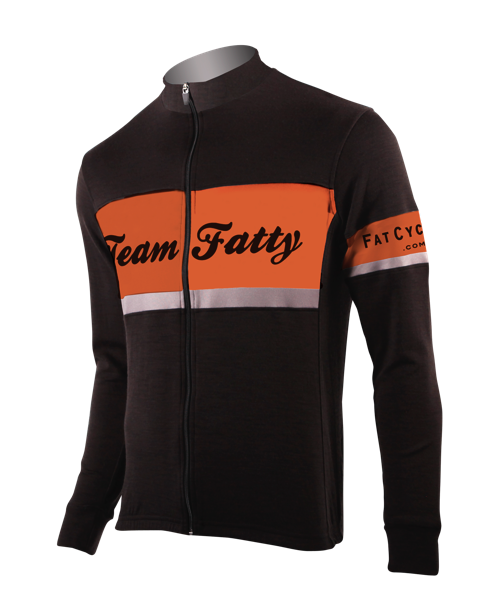
You will never ever want to wear anything else, ever again. Well, at least not until next summer.
Details tomorrow!
Comments (14)
11.6.2014 | 1:07 pm
A Note from Fatty: This is the third and final part of my report for the Utah State Triathlon Championships. You’ll find Part 1 here, and you’ll find Part 2 here.
The race, as far as I was concerned, was over. I had survived the swim and had raced the time trial. Later, I’d find I was the fifth-fastest person on the bike, overall. I was happy with how I had done.
But all of the urgency had gone out of me, along with any semblance of energy. I just had to survive this half marathon. Run it when I could, walk it when I had to.
Did this mean I wasn’t going to try? Heck no. When I race, I race for real. I was going to go as hard as I could. But I have to be honest with myself: I am not a good runner, and this would be the first time I’d run more than eight miles the whole year. And the first time I’d run on pavement in just as long.
So I sat down to put on my running shoes: the magnificent, ultra-cushy Altra Paradigms (Full Disclosure: I bought these myself at a regular ol’ store. I just happen to love Altras).
And I ate a packet of Honey Stinger Chews while I tied the laces. And then I drank a Red Bull. And then ate another packet of Honey Stinger Chews.
OK, now I was ready.
Help, I’m Lost
I am never anything but comical when I run. I have terrible form, and I am not fast at all.
But when I’ve just gotten off a bike, I’m hilarious. My legs, completely exhausted and programmed to execute one particular motion, seem completely unable to comprehend this new motion.
And it feels like this—a peculiar, awkward, stumbling sensation—for about a third of a mile. Then, while I never become graceful, I at least start to find some kind of stride.
But about the time my legs started feeling…well, not good, but OK with the action of running, massive paranoia started creeping up on me.
There were people running in the opposite direction of me. That in itself was no big deal, because I knew that the Olympic-distance racers would be finishing their races well before I did.
But they were smiling at me. Like, every single one of them. And I wasn’t sure what those smiles meant. Were they smiling encouragement at me, because they thought they were a lot faster than I was, mistaking me for being one of the very last Olympic-distance racers to begin the run (as opposed to one of the very first Half-Iron distance racers to begin the run)?
Were they just being nice?
Or were they—and this was my fear—smiling at me because I had messed up, and was not on the course?
I thought back to when I had gotten off course at the Jordanelle Triathalong, and how as I came down the section of the road I shouldn’t have, it seemed a few people were smiling at me, in much the same way.
I looked forward, hoping to see a course marker, telling me I was doing OK.
Nothing as far as the eye could see.
I looked forward and backward, hoping to see another runner going in the same direction I was.
Nothing. Nobody. I was alone. Was this because I was way ahead of all but a few of the racers at this point? Maybe.
Or maybe it was because I had missed a turn somewhere, and was now off-course.
The thought demolished me.
I slowed to a walk. Then I stopped. Then I turned around and started running the other direction.
Then I started second-guessing my second guess. What was I doing? And why was this course so incredibly poorly marked that I even had to deal with this question?
I turned back around and started running again. A few weeks prior, The Hammer and I had come and pre-rode and pre-run parts of this course as it was described on the site. Of course, the course as described on the site wasn’t much like the cycling course I had just ridden, but I was going to trust that the running course hadn’t changed; big chunks of it were just unmarked.
I followed the road as I understood the course should go, hoping that the people coming in the opposite direction were a good sign, and not a sign that I was salmoning this half marathon.
Finally, after about a mile, a sign. I had in fact run the course correctly to this point, and I knew how the rest went.
What a relief.
Looking for The Hammer
The half marathon was an out-and-back thing, which I was really happy for: when you’re racing, out-and-back courses give you a great opportunity to see exactly where you stand in the race, as well as to encourage people going in the opposite direction.
At first, I ran along, wondering when I’d see the first person coming in the opposite direction. I was excited to see I had gone about four miles before he came by me. I gave him a shout, then kept on going.
More people came by me, though not very many. I was doing OK in the race—I figured I was fifth or so overall.
And then runners started passing me. Now I was sixth. Now seventh. Now eighth.
That’s OK, I thought to myself. I knew this would happen.
I stopped wondering about my own place in the race—there was nothing I could do about the people who were flying past me—and began wondering when I would see The Hammer.
I was sure I’d get to the turnaround point before I saw her. And I had high hopes I’d get to her mile 5-mile mark before she caught and passed me.
My split times for the miles get slower and slower:
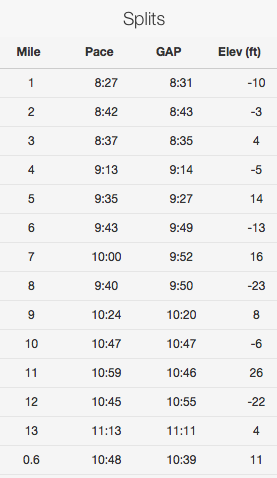
By the time I had run seven miles (now at a ten-minute pace), I knew for absolutely certain that The Hammer would in fact catch me. That, as is increasingly common, she would be waiting for me at the finish line.
Sneaky
Then, shortly after I hit the turnaround spot, I saw her. I knew it was her before she was close enough for me to see her face clearly; I recognize her running style.
I briefly reflected on how cool it was that I can recognize my wife by the way she runs.
I had hoped to be able to yell out to her that she was winning the women’s division, because I had not yet seen another woman on the course.
But there was a complication: The Hammer was not running alone.
Right beside her—the two of them engaged in pleasant conversation—was another woman.
“This ain’t no time for jibber-jabber,” I said to myself, echoing a phrase The Hammer often uses when we’re training. But when she runs, The Hammer loves to chat. In fact, I’d say when she runs is when she’s the chattiest. And—as an aside here—I think it disappoints her that I am completely unable to engage in conversation when I run with her. She’s feeling expansive and talkative; I’m just hanging on.
Anyway, as they got closer, I could tell that the woman The Hammer was running with was young. College-age, or maybe just out of college.
This was not an insignificant fact.
Why?
Remember way back in the first post, where I mentioned that the young racers—the ones in the white caps—started five minutes before us oldsters?
Well, I remembered it. And I could tell that while they were physically side-by-side right now, the woman The Hammer was running with had a five-minute head start.
Which meant that, even as these women ran together, amicably chatting, The Hammer had a five minute lead. I knew that. I knew The Hammer knew that.
I did not know whether the woman she was running with knew that. And I sure wasn’t going to tell her.
I shouted a greeting, The Hammer ran ahead and gave me a kiss, and then the two of them continued on their way.
Hi and Goodbye
I wasn’t kidding when I said that I haven’t run more than eight miles this year, nor have I run on the road at all. And it showed. As I hit mile nine, my pace slowed to 10:24. I ran the tenth mile in 10:47. And from there on out, I was either at or on the cusp of eleven-minute miles.
Like I said, I was just hanging on.
So around mile eight, the woman who had been running with The Hammer cruised by me—a little faster than The Hammer, she had pulled away.
Moments later, The Hammer caught up with me.
“You know you’re actually five minutes ahead of that woman, right?” I said.
“Yeah. I don’t think she knows it, though. My mission is to just keep her in sight,” The Hammer replied.
“Go go go!” I yelled.
And The Hammer went. You may be entertained to see what her running splits looked like:
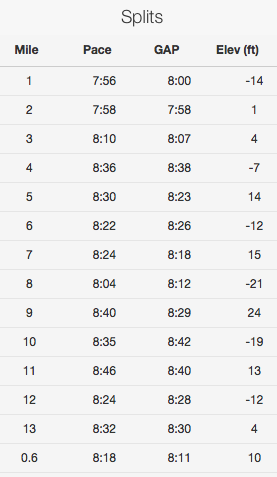
Yeah, I’d say she’s a little faster than I am.
The Hammer disappeared, and I struggled on, proud of the fact that—while I was clearly going slow—I had not (nor would I ever during this race) go to a walk. Except when I was at the aid stations, getting a drink. That didn’t count.
Another Threat
As I hit about mile ten, another woman passed me. Just rocketed by.
I found myself posing a story problem to myself:
If one woman, running 8:30 miles passes a man who is running 11:00 miles eight miles into a 13.5 mile race, then another woman, running 8:00 (or possibly faster) miles passes that same man ten miles into that race, which woman will win the race?
The answer, strangely, would depend on a factor not included in the story problem: the age of the second woman.
Which I did not know, having only seen her backside (and I was unable or unwilling to judge based solely on her backside).
We’d find out the answer really soon.
Surprise Finish
There isn’t much to tell about the rest of my race. I survived to the finish without ever slowing to a walk. Although what the difference is between an eleven-minute-mile run and a walk may be a discussion worth having.
The Hammer was waiting for me at the finish line, as expected.
“How’d you do?” I asked.
“Well, a woman caught me right as we got to the last mile, and we ran together for a second. I wasn’t sure, so I asked her, ‘What color of swim cap were you wearing in the swim?’”
“The woman answered me, ‘White. Everyone racing the half-iron distance was wearing white.’”
“So I said, “Sorry, honey, but there was a wave of us wearing yellow caps, five minutes behind you. You’d better hurry if you want to beat me.”
“The woman didn’t say anything. She just looked at me like she didn’t understand what I was talking about, and then sped away.”
And in the end, The Hammer won. Not just her age group, she won the overall: all women. By more than five minutes.

It’s interesting to note that while The hammer lost about ten minutes to each of these women in the swim, she absolutely dominated the bike, putting 17 – 20 minutes into the second and third place women, respectively.
In fact, The Hammer was the ninth fastest person in the race (i.e., including men). (I was 15th).
The Hammer, my friends, is a force to be reckoned with.
Podium
Here’s the Hammer, with Jenessa and Sarah, the overall podium for the Utah State Half-Iron Triathlon Championships:
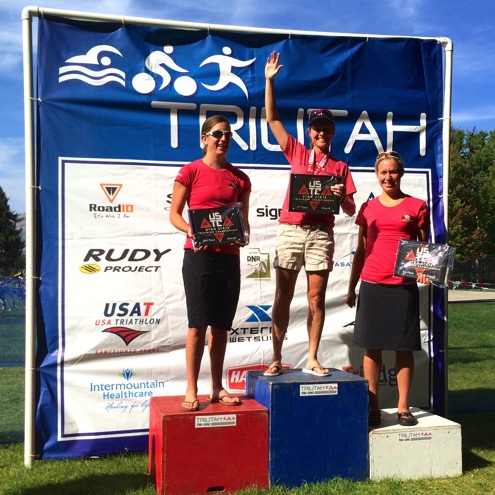
And, as it turns out, I got on the podium, too, for the Men’s 45-49 age group:
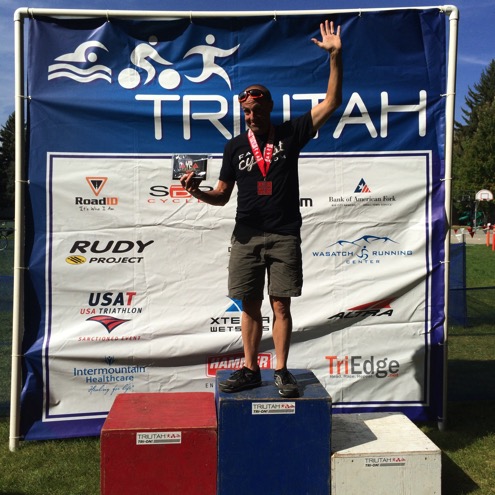
Of course, being the only one on a podium makes you feel just a little bit dorky. Everyone knows why nobody else is up there, right?
Which is why I look like this, holding up my “Congratulations on being the only one to race in your age group” plaque:
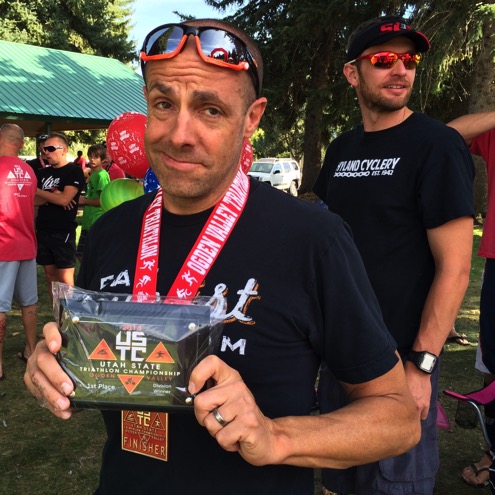
But it’s a cool photo, because Chris Wright, a fast guy and Friend of Fatty, did a great job of casually photobombing the shot.
Oh, and afterward, I found out that there had been a couple more guys who had raced and finished in my age group.

They just happened to still be on the course when the photo was taken. Accordingly, I have adjusted my podium photo to include them.
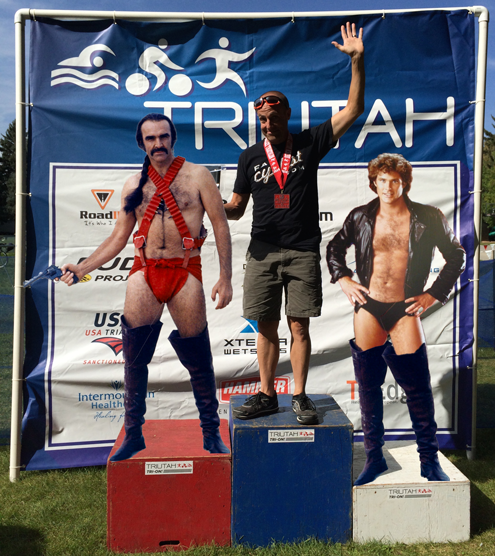
Sean Connery is playing the part of Matthew Harrison; David Hasselhoff is playing the part of Daryl Ballantyne.
Two triathalongs down. One to go.
Comments (21)
11.5.2014 | 12:14 pm
A Note from Fatty: this is Part 2 of my USTC Race Report. You’ll find Part 1 here.
I couldn’t believe what was happening to me. Just couldn’t believe it. There’s one single part of triathalong that I’m good at: the time trial. I can get low, spin up, and fly by practically everybody when I’m on my Specialized Shiv.
I suck in the water; I suck in the run. But I am strong enough on my bike that I still wind up being one of the sorta-kinda fast guys overall.
Unless, of course, I can’t shift. Which I couldn’t.
My bad luck was driving me nuts. It’s not like the Shimano Di2 is flaky; it is absolutely positively the precise opposite of flaky. It’s more reliable than mechanical shifting, and has never failed me during training, and has given me trouble only twice, ever.
It’s just that both times, it was during a half iron-distance tri.
The first time this happened, it just righted itself, and I held out hope that it would do the same thing this time.
But after five minutes of riding, as I dawdled along pressing buttons, re-seating the battery, and re-seating the cable that plugs into the rear derailleur, I lost hope in the possibility of a self-healing drivetrain.
I started passing people again. I got up to about 21mph. Not bad, but not what I wanted. “Lisa’s going to pass me soon, I’ll bet,” I thought to myself.
I tried to resolve myself to my fate. I tried to start rewriting this story in my mind (changing it from the “dominating on the bike” narrative to a “well, let’s try to have fun” narrative). I tried to focus on spinning fast instead of with a lot of power. I tried to be cheerful about my new reality for this day.
I tried to do all these things, and failed entirely.
I stopped and got off my bike. Pulled the cable that plugs into the rear derailleur out one more time (my third). Plugged it back in, putting a little bit of extra force. Twisted it a little bit. Felt a click I hadn’t felt the other two times. Like something had…connected.
I got back on my bike. Hopeful. Doubtful. I spun up to ten or fifteen miles per hour, and pressed the button to shift the rear derailleur.
Not expecting, but hoping.
“Bzt.”
That’s the sound a Di2 rear derailleur makes when it shifts.
When it SHIFTS!
I started laughing. With joy. With relief. With a sense of purpose, regained.
My bike was shifting perfectly again. Would have been shifting perfectly all along, if I were better at diagnosing problems.
But I was in no mood to beat myself up. I was in the mood to absolutely positively gut myself on this ride.
Plan Into Effect
Weeks before this race began, I had come up with a plan. A plan I intended to execute at every triathalong I was going to race this year. I had explained it to The Hammer like this:
“I can’t swim, and I can barely run. So why should I save myself for those events? I’m going to go slow on the swim so I can survive it, then try to knock the bike portion out of the ballpark, without worrying at all whether I’ll have anything left in the tank for the run. If I have to walk it, I’ll walk it. If I have to stop, I’ll stop. But for me, these races are going to be all about the bike.”
And now I was putting that plan into effect. I immediately started passing the people who had gone by me as I was struggling with the mechanical earlier.
Then I came to a T in the road—the left turn headed toward a monastery, the right turn headed out toward the rest of the loop. My understanding was that we’d be going to the monastery, turning around there, and continuing on the loop. I wasn’t sure, though, because that morning the race director had announced that there were changes to the course; we’d be going around the reservoir three times instead of two, with another part of the course eliminated.
But he hadn’t said anything about eliminating the monastery spur.
On the other hand, there were no course markings showing that we should go one way or the other. And no course marshal giving any indication of which way to go, either.
Then a teenage boy came running up to the intersection—a course marshal delinquent in his duties, I guessed—and pointed toward the monastery. “Go that way!” he shouted, and I did.
I hammered up the road toward the monastery parking lot. As I got close, I saw another rider coming toward me, shaking his head. “Nice course markings,” he said.
At the moment, I assumed he meant the absence of any indication which way to go at the T intersection.
I was wrong.
As i got to the parking lot, I looked for a cone, a course marshal, or something indicating where the turnaround point is.
Nope. Nothing.
So I turned around at what I judged would be a good spot for turning around—the midpoint of the parking lot—and headed back.
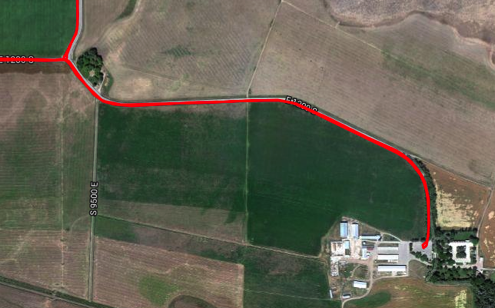
The course comes from the red line at the top of the image; we rode to the monastery parking lot in the bottom right of the image, and then back and out the top left.
Halfway there, I saw The Hammer; she was only a half mile behind me!
“Whooo!” I shouted.
“Whooo!” she shouted back.
I thought about saying something about the weird lack of marking at the monastery parking lot, but what was there to say that she wouldn’t find out herself in two minutes anyway?
I put my head down and charged ahead.
Go, Go, Go!
Apart from the confusing intersection at the monastery, the bike course for this half-iron distance is wonderful. It’s really rare for me to get a chance to get to ride so far without hills. There was only 1535 feet of climbing in the entire race, with an elevation profile that looks essentially flat:

It was nice to focus on just going all-out fast.
We were going around the Pineview reservoir a total of three times, with an extra little loop out toward the monastery twice (on the third time around, we’d skip the loop out to the monastery).
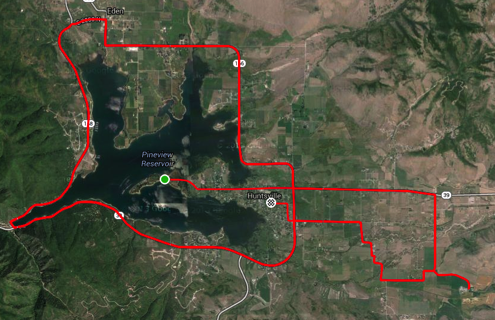
I’m pretty sure I was never not passing people. At first I was passing just people doing the half-iron distance. Then I caught and passed people doing the Olympic distance.
Weirdly, on the second lap, I would then pass many of the Olympic-distance racers a second time, because they didn’t do the little side loop out toward the monastery.
Which gave me the singlularly-satisfying opportunity to say, “On your left again,” from time to time.
I was going at my absolute limit, just racing with all my might. and I was incredibly happy.
No, happy isn’t quite the right word. I was focused. Purposeful. I was doing something I love doing, and I was doing it really well.
Drinking a little, eating a Gu Roctane every twenty minutes, on the dot. Never ever running out of power, never getting a sick stomach.
I have figured out how to race, eat, and not get sick. I have figured out how much effort I can maintain without blowing up.
It’s a fantastic feeling.
The Second Lap
As I got to the turn to the monastery on the second lap, I was looking forward to—this time—not having to slow and make the decision which way to go. This time I’d come into the left turn with speed, fly to the parking lot, turn around in some arbitrarily-chosen spot, and then head out.
I wondered how far ahead of The Hammer I was. Would I see her on this out-and-back spur again? I didn’t think so. She and I are very similar when there’s a course with climbing, but in a flat raw-power course like this, I figured I’d be putting time on her in a big way.
I got close to the intersection, veered right and then cut left, not wasting effort with braking. Feeling great.
And then:
“NO!”
I braked hard. Who shouted that? I pivoted my head around, and there was a woman, running to the intersection, and waving me back.
“You’re not supposed to go that way!”
I turned around, confused. Wary.
“The race doesn’t go that way!” she shouted, again.
“OK,” I said. “Maybe you should stand where racers can see you, blocking the wrong way and waving people in the correct direction.”
Later, when I talked with The Hammer about the race, she told me that when she got there, the woman was in fact doing that.
Check me out: making the world a better place, even as I race.
Transition
There isn’t much more to say about the bike portion of this tri. I kept my head down, hardly seeing anything more than my front tire and the road. I stayed focused and rode with all the power I could muster.
And in the end—even with the problems I had with my bike at the beginning of the race, I did a time trial I’m incredibly proud of:
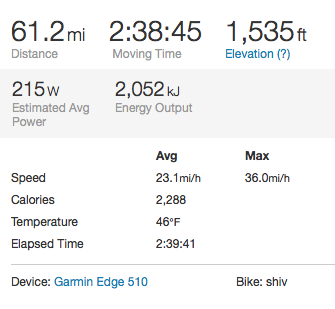
Strava shows that I was stopped for about a minute during the race; I’d say that’s a conservative measurement of how much time I lost due to my early goofiness. Between going slow and getting off three times, I’d say I probably was about three or four minutes slower than I would otherwise have been.
Even so, that’s 23.1mph, on average, for 61.2 miles.
Which isn’t half bad. Although it is about five miles too long for a half-iron distance race. I’m not complaining, though. The more biking, the merrier.
I racked my bike—one of very few that had arrived so far for the half-iron distance race.
The only problem was, now I had a half marathon to run. And I was completely smoked.
I knew that my moments of glory were behind me for this race; now I just needed to struggle on as best as I could.
Meanwhile, the real race—complete with a twist ending you are just going to love—was about to begin.
Which is where we’ll pick up in the final installment of this race report.
Comments (10)
11.4.2014 | 11:49 am
A Note from Fatty: Today’s 100 Miles of Nowhere race report comes from Amy Thompson, who is one of the three nicest people in the whole world.
100 Miles seemed an impossible distance to me. Until four years ago, I would not have even considered it. Four years ago, my husband Dave, signed us up for the ride explaining that we needed to push our son, Rob, to do longer rides. Rob sustained a brain injury six years ago when he was 19. Dave built a tandem three wheeled trike to help in Rob’s recovery. Dave sits in the back and Rob is in a recumbent position in the front.
Dave has been cycling seriously since high school. One hundred miles isn’t a big deal for him.
Rob loves to bike. When he began to speak after emerging from his coma, he regularly asked if he could bike. They were both eager to do a 100 mile ride.
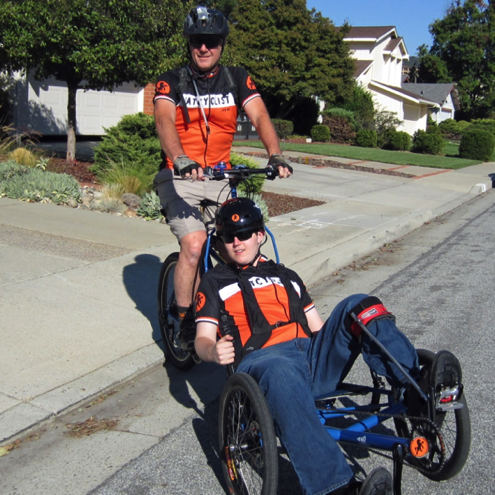
Suffering on a bike is not my idea of a fun time. But this was not about fun, this was about a cause; helping Rob walk again. So I reluctantly agreed.
Our first 100 Miles of Nowhere took more than a month. We would bike about twelve miles at a time. After which, Rob’s legs would tense and shake involuntarily from the workout. I was worried it was hurting Rob. Dave was worried he wasn’t tolerating longer distances. Like many parents, we had different ideas about what Rob needed.
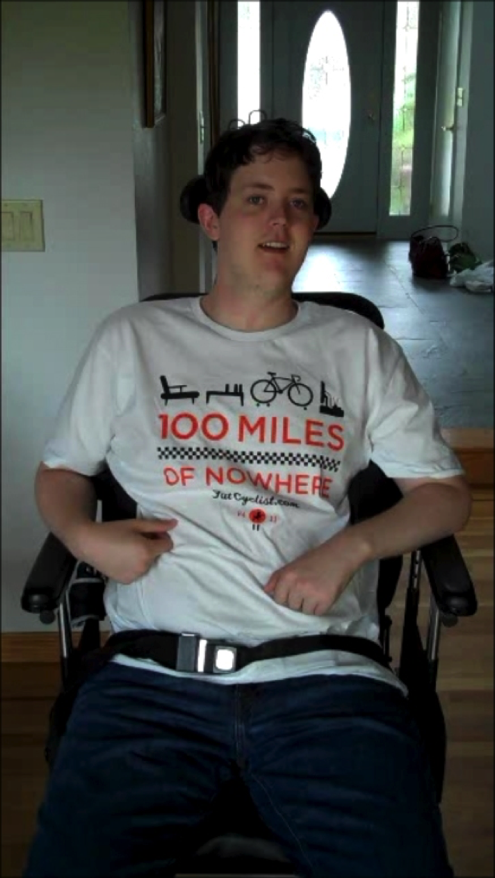
Rob and Dave continued to ride throughout the year. I continued to believe that Dave pushed Rob too hard. Often I chose not to ride with them because it was hard for me to watch. Rob’s legs would rub against the tires during a ride because he didn’t have enough muscle strength to keep his knees from splaying out during a ride. We didn’t realize how bad it was until we took his jeans off and saw the raw sores on the outside of his legs. Dave had to add bars coming up from the pedals to strap Rob’s legs in place so they wouldn’t rub against the tires.
In 2012 Dave signed us up again. Not only was he expecting us to ride, we were going to get up early and drive nearly two hours to ride with other people. I was furious. I thought Dave was setting us up for failure. What I didn’t expect was how nice and supportive the FOF’s were. We rode a 20 mile loop chatting with other riders. Rob was in heaven with all the attention. As we headed for home, Dave started planning the 2013 ride.
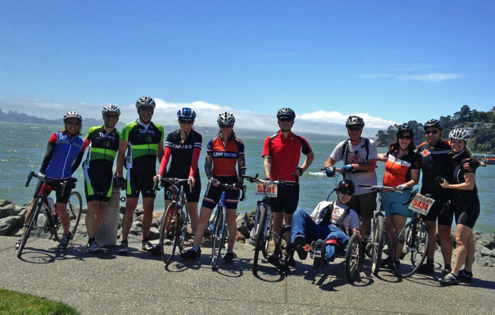
Three years after Rob’s accident, we were riding the Livestrong Challenge in Davis and setting a new record, 43.6 miles. It took us longer to ride those 43 miles than it took Elden and Lisa to ride the 100 mile course. I remember saying to Elden after the ride, “I can’t imagine ever being able to ride 100 miles. How do you do it?”
“You just keep doing it and it gets easier and easier,” Elden said. “You could do it.”
I wanted to laugh. But Elden was sincere. I knew he believed that.
This year we rode 60 miles at Levi’s Gran Fondo in Santa Rosa. Well, honestly, Dave and Rob rode 60 miles. I hiked several of the hills and biked the rest. Several times during the day I recalled my conversation with Elden. I knew I could do 60 miles that day. At the end of the day, Rob was tired but his legs weren’t shaking. Dave and I were both amazed at Rob’s progress.
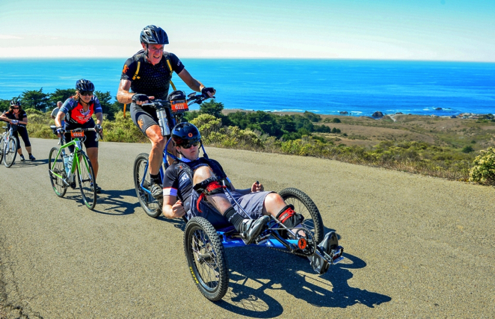
A month later we hosted and rode laps from our house for the 100 Miles of Nowhere. Dave invited 20 people and I stocked up for 20ish hungry cyclists. We had to move the date at the last minute because of rain. Only one other rider showed up, Steve Banks.
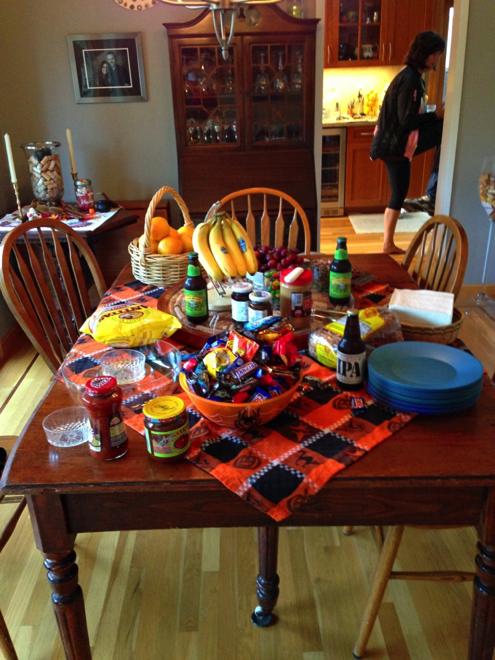
I was hoping to set a new record for myself, but it wasn’t my day. Dave and Rob, however, biked 65 miles, a metric 100mon. They biked as long as they could. For the first time since they have ridden together, they both hit the wall. Dave considered that a huge accomplishment.
I am so proud of both of them.

I still think 100 miles is a crazy long ride. Now, I know some day the three of us will do it. All we have to do is keep riding until it gets easier and easier. After all, it’s for a good cause.
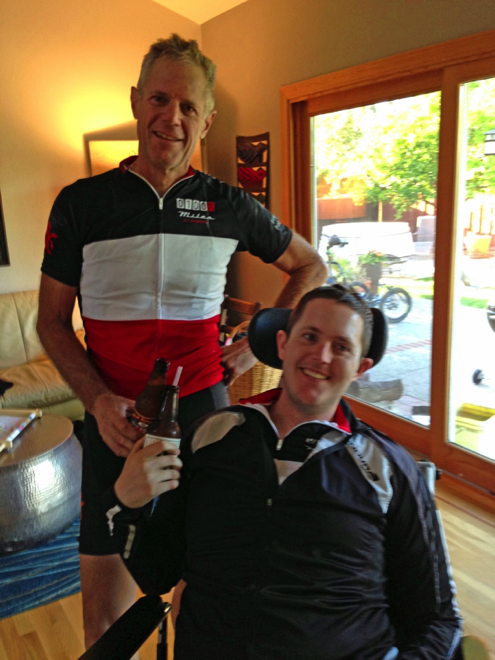
Comments (36)
« Previous Page — « Previous Entries Next Entries » — Next Page »
































